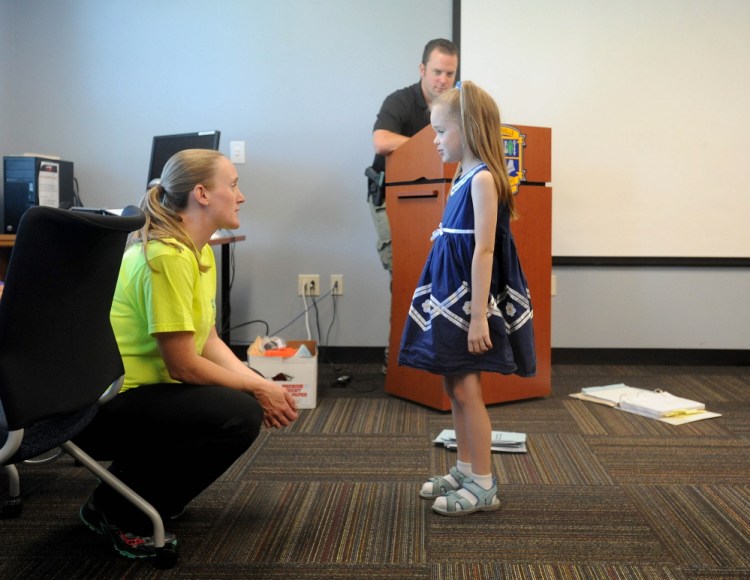When I was a kid, grownups told us never to accept candy from a stranger or get into a car with one.
It was good, basic advice, but I don’t remember anyone ever giving us specific instructions for what to do if we got lost in a store, grabbed by a stranger or accosted by an angry dog.
The world was a different place back then. It was less intimidating, quieter, safer.
Now, we hear horror stories all the time about kids being hurt, abducted or killed. It is important we give them skills they can use to help protect themselves.
Jody Almeida, of Waterville, mother of 7-year-old Emily, says parents often tell their children, “Be safe,” but do they really know how to teach them what to do to physically protect themselves?
That’s where Sgt. Jennifer Weaver of the Waterville Police Department comes in.
She teaches a radKIDS Personal Empowerment Safety Education class to children ages 5-12. Weaver is a nationally certified instructor for the program, which gives children hands-on training in home, school and vehicle safety. They learn about being safe when they’re out and about in the community, how to physically defend themselves from a potential abductor, what to do when approached by a stranger and more.
Emily Almeida attended Weaver’s class last week at the police department with several other kids. They spent two hours a day for five days with Weaver, practicing how to act and move in various situations. With help from school resource officer Damon Lefferts, Weaver set up scenarios where the kids role-played being in a store and being accosted by a stranger.
It’s OK, Weaver said, to make a scene, yell — “You’re not my mother; you’re not my father!” — and create an obstacle — knock food off shelves, turn over a trash can and do whatever else is necessary to get away from the stranger. With Weaver playing the stranger and Lefferts a store clerk, the children, one-by-one, went through the motions of being in a store, yelling, dropping a backpack in the stranger’s walking path, knocking over a trash can and running to a store clerk, describing the stranger and what she said, and dialing 911.
Weaver cited three rules that children should always remember:
“Nobody has the right to hurt you, because you’re special. You don’t have the right to hurt anybody else unless they’re trying to hurt you. And it’s never your fault, so you can tell somebody.”
Jody Almeida watched as her daughter took part in the class activities.
“I think the class makes her feel more confident, more empowered to stand up to bullies or handle any situation where she doesn’t feel right,” she said. “It gives kids more specific things to say, some actual tools, instead of somebody just saying, ‘Stand up for yourself.’ My husband and I always tell her not to talk to any strangers. Well, that’s so generic. Here, they give them specific situations they can relate to.”
Jody Almeida said she was learning things she had never thought about, such as the importance of not putting a child’s name on a backpack, shirt, necklace or other item, as a potential abductor could use it to approach a child, call him by name and say a parent sent him to drive the child home.
“Kids are so trusting,” she said. “They figure, ‘That person must know my mom. They know my name, so it must be OK.'”
Emily said she loves the class.
“It’s awesome because I like doing everything — learning about how to be safe,” she said.
Weaver also taught the kids about how to be safe around dogs.
“Never approach or tease a dog, especially if it’s on a leash or on the other side of a fence,” she said. “If we come across a mean dog, we’re going to leave the area and tell an adult. Don’t get close. If a dog comes toward you, stay calm. If you run, the dog thinks it’s a game and will chase you. We’re not going to scream, run or turn our back on the dog.”
She said the kids should let a dog sniff them, and if the dog starts to bite, they should give it their back pack or jacket to chew on.
“Get down and cover up your face,” she said, demonstrating how to get on the floor, face down. The children followed suit.
“We want to protect our face and our neck,” she said.
Kristina Wood, of Belgrade, watched as her children, Ethan, 8, and Abby, 6, took part in the activities. Wood said she had taken the women’s version of the class three times. That course is R.A.D. Systems, which stands for Rape Aggression Defense.
“I highly recommend it,” she said. “It’s good just to have the knowledge of ‘just in case.’ Boy Scouts have to be prepared. Girls need to be prepared, too.”
In 2009, I took the class with Weaver and Meg Hatch, an advocate for the Sexual Assault Crisis & Support Center. I learned all sorts of valuable stuff, including basic physical defense techniques.
Weaver now teaches women and kids classes a couple of times a year and welcomes new students and those wanting to take a refresher course. I asked her if she could cite a specific instance where the class helped someone in a dangerous situation. Weaver recalled a woman who decided, part-way-through the class, not to remain in a domestic violence situation she was in.
“She decided she was going to leave, and her husband attacked her when she told him,” Weaver said. “She was able to protect herself and get away from him and seek medical treatment. She reached out to myself and Meg. She was not from the Waterville area and it wasn’t in our jurisdiction, so we were able to get her in touch with the proper agencies and file a protection order.”
I suspect there are many more such success stories stemming from Weaver’s instruction. While we may never hear about them, we can rest a little more easily knowing she’s out there — helping one adult, one kid at a time.
Amy Calder has been a Morning Sentinel reporter 27 years. Her column appears here Mondays. She may be reached at acalder@centralmaine.com.
Send questions/comments to the editors.



